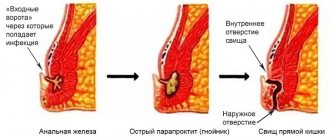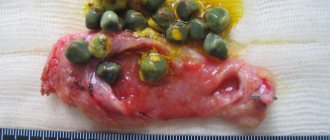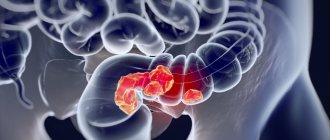Anal cancer is a life-threatening tumor of the final part of the rectum, which ends at the anus.
Such neoplasms are called malignant because their cells multiply uncontrollably, grow into surrounding tissues and affect organs located far from the main focus of the disease.
How does anal cancer develop?
Cancer begins with the appearance in the body of a mutated cell - an altered cell that differs from normal ones. It arises due to exposure to harmful substances or diseases, grows and creates many copies of itself. Most of them are detected and destroyed by the immune system, but some manage to hide from or resist our natural defenses. Over time, those that were able to survive form a tumor and destroy surrounding tissue. In addition, they have several other dangerous properties. Unlike normal cells, the place and time of birth and death of which are clearly defined, cancer cells can spread throughout the body and do not die in due time. They enter the circulatory or lymphatic system. The lymphatic system complements the cardiovascular system. The lymph circulating in it - intercellular fluid - washes all the cells of the body and delivers necessary substances to them and takes away waste. In the lymph nodes, which act as “filters,” dangerous substances are neutralized and removed from the body. systems, through their vessels spread to various parts of the body, become established in them and create metastases - additional cancerous tumors.
What is the anal canal?
As food is digested, it passes from the stomach to the small intestine, and from there moves to the large intestine, where water and salts are absorbed.
The resulting waste is stored in the rectum, from where it exits into the anal canal
.
It has a length of 3 to 5 cm and consists of two muscles - sphincters, which keep the anus closed and prevent stool from leaking out. The feces then pass to the anal verge
, the place where the canal connects to
the perianal skin
covering
the anus
, through which the contents of the digestive tract exit the body.
The anal canal consists of:
- the inner, mucous membrane, in the cells of which most of all cancer cases begin;
- glands located underneath that produce mucus that lubricates feces and facilitates their removal from the body;
- and ducts - tubes through which the fluid secreted by the glands passes.
How does an adenoma turn into carcinoma?
Rectal cancer.
Rectal cancer is one of the most studied malignant tumors. Typically, colorectal cancer develops from benign intestinal polyps (adenomas). This process may take more than one year. The change from polyp to cancer involves irreversible changes (mutations) in the genes of the cells lining the intestinal wall. This leads to the loss of natural mechanisms of cell division, which, in turn, causes their uncontrolled growth, that is, transformation into cancer cells. They ignore the normal boundaries of surrounding tissues and grow into nearby structures. This process is called invasive tumor growth. These cells penetrate the thickness of the intestinal wall, pushing aside and destroying the natural cell mass. Having reached the blood and lymphatic vessels, they are transferred to other parts of the human body, forming daughter tumors. These colonies are called metastases. The process of carcinoma formation from a benign intestinal polyp can take approximately 5-10 years. The risk of cancer increases with age. Most patients with colorectal cancer are over 50 years old. Gene mutations can also be hereditary, that is, transmitted by inheritance. In such cases, the process of tumor formation proceeds faster and cancer may occur at a younger age.
Types of oncology of the anal canal
Doctors identify several types of life-threatening tumors in this area of the digestive system:
- Most cases are squamous cell carcinoma
, which begins in the squamous cells lining much of the anal canal and rim. - Much less common are adenocarcinomas
that develop in the glands or cells lining the part of the anus located near the rectum. - Basal cell carcinoma
: Forms in the perianal region - the skin located around the anus. - Melanoma
: occurs in cells that produce pigment, the substance that colors the skin brown. Such neoplasms usually appear on exposed parts of the body, and only a tiny part of them begins in the anal canal. - Gastrointestinal stromal tumors
develop in the so-called Cajal cells, which set the rhythm of intestinal contractions. They usually affect the stomach or small intestine, and very rarely the anus.
Computed tomography (CT).
Rectal cancer.
This is a radiological method that visualizes the human body as virtual slices. In patients with rectal cancer, CT scanning of the chest, abdomen and pelvis can reveal affected lymph nodes and metastases in other organs (liver, lungs). For a better examination of the gastrointestinal tract, the patient drinks a contrast agent about an hour before the examination. Immediately before the CT scan, the colon is also filled with a contrast agent administered through the anus. This allows for good visualization of rectal tumors.
Causes of anal cancer
Today, doctors and scientists do not know the exact causes of this type of oncology - they only know about the factors that can trigger the onset of this event.
- The main ones include HPV - human papillomavirus
, which increases the risk of developing cancer of the cervix, vagina, vulva. The vulva is the external female genital organs, which include the lower part of the pubis, the clitoris, the labia majora and minora, the vestibule of the vagina, the opening of the urethra - urethra, and the perineum - the area between the lower edge of the labia majora and the anus., penis, mouth and throat. HPV can infect cells that are on the surface of the skin and line the genitals, anus, mouth and throat, but does not infect the blood or internal organs such as the heart or lungs. The disease can be transmitted through skin-to-skin contact, vaginal, anal and even oral sex. Different types of HPV cause wart-like growths on different parts of the body: arms, legs, genitals, lips or tongue. Currently, there is no cure for this infection, but there are vaccines that prevent infection and methods that allow you to get rid of new growths that have appeared. - Other types of cancer in women
, such as cancer of the cervix, vagina or vulva, increase the likelihood of developing dangerous tumors of the anal canal. Perhaps this connection is caused by the influence of the same HPV. - HIV
, the human immunodeficiency virus that causes
AIDS
are especially at risk. AIDS is acquired immunodeficiency syndrome, the final stage of HIV. It enters our bodies through fluids that other people secrete—except saliva, sweat, and tears—and its particles weaken our natural defenses. As a result, the body becomes extremely vulnerable to any disease. - Sexual activity
. Having multiple sexual partners increases the likelihood of contracting HIV and HPV, as well as the occurrence of anal cancer. - People whose immunity is weakened not only by AIDS, but also by taking special medications prescribed after organ transplantation are more susceptible to this type of cancer. Such drugs do not allow the body to fight against new tissues that are foreign to it and reject them, but they deprive a person of the ability to resist infections and dangerous tumors.
- Smoking
is a known risk factor for many types of cancer, since cigarette smoke contains carcinogens - substances that can trigger the development of life-threatening tumors. - Gender and race
: The disease is more common in Caucasian women and black men.
Symptoms and signs of anal cancer
As a rule, in the first stages of cancer no health problems arise; usually a person notices them only after the tumor grows to a large size.
- The first symptom is often minor bleeding
. Most patients take it as a sign of hemorrhoids - enlargement of blood vessels located in the lower part of the rectum: outside - at the entrance to the anus, and inside it. - Itching in or around the rectum.
- Lumps, swelling or growths in the anus.
- Long-term and unexplained changes in bowel habits – frequent diarrhea or constipation.
- Unusual discharge from the anus.
- Pain or feeling of pressure in the anal area.
- Bowel incontinence is a loss of bowel control.
- Changes in the shape of feces - their narrowing.
- Feeling of fullness in the intestines even after bowel movements.
- Enlargement of the lymph nodes located in the groin - small pea-sized organs that trap and neutralize dangerous substances.
- Difficulty with bowel movements.
- Unintentional weight loss.
- Fatigue or weakness.
- Nausea.
Most often, these symptoms are not related to cancer - in the vast majority of cases they are caused by hemorrhoids, anal fissures or anal condylomas - warts.
If any of them appear, you need to see a doctor as soon as possible, who will quickly diagnose and prescribe treatment. Anal cancer or hemorrhoids?
Independently distinguishing one condition from another is quite difficult and not always possible. As a rule, the above problems are caused by hemorrhoids if:
- the person has certain risk factors, such as pregnancy, constipation and the resulting strain during bowel movements, or has already had hemorrhoids at least once;
- the condition improves after home treatment - consuming large amounts of fiber, taking sitz baths or using special creams and suppositories;
- swelling, lumps or bulging veins are visible in the mirror;
- symptoms come and go, but do not get worse over time, and new ones, such as unintentional weight loss, do not occur.
Colonoscopy.
Rectal cancer.
This is the most informative method of examining the colon. It involves inserting a flexible instrument (endoscope) through the anus and is accompanied by illumination and examination of the inner surface of the colon and rectum. To maximize visualization of the intestinal wall, it must be adequately cleansed using special laxatives or an enema. Colonoscopy is the only method to confirm colorectal cancer because tissue samples (biopsy) can be obtained. In addition, intestinal polyps can not only be detected, but also removed during this procedure.
Diagnosis of anal cancer
The examination is a very important point, since during it doctors not only detect the disease, but also find out how seriously the body has been damaged. They identify damaged tissues, based on the information received, provide approximate prognoses of the course of oncology and select the most appropriate treatment in each specific case.
Lapino-2 specialists carry out a complete diagnosis of anal cancer - quickly and efficiently, using the most modern equipment. With us you can perform any research without leaving the center - in one place, without queues or delays.
The examination begins with a survey about disturbing symptoms and risk factors that can trigger the development of a dangerous tumor. After this, an examination is carried out, including a gynecological examination for women, and a Pap smear, which can be used to detect abnormal cells in the vagina and cervix. The doctor examines the condition of the anus and rectum, assesses the condition of the lymph nodes of the groin area and prescribes a number of procedures:
- Finger examination
. - Anoscopy
: examination of the mucous membrane of the anal canal and lower part of the rectum using an anoscope - a short, hollow, solid tube with a light source at the end. - Proctosigmoidoscopy
: assessment of the terminal portion of the rectum using a proctosigmoidoscope, an elongated instrument similar to an anoscope. - In some cases, a colonoscopy
- an examination of the intestines through a colonoscope, which is a long, flexible, thin tube with a light source and a camera. - A biopsy
is the removal of a small amount of suspicious tissue and its transfer for examination to a laboratory, where a specialist studies the properties of the cells. - Blood tests
, including for HIV. - Ultrasound,
including transrectal - with insertion of a sensor into the anus. The method allows you to see the depth of damage to the tissues located next to the anus. - CT scan –
This is done to evaluate damage to the lymph nodes or other parts of the body, such as the liver or lungs. - Magnetic resonance imaging, MRI
- is prescribed to study the condition of soft tissues, including the liver, brain and spinal cord. - Positron
emission
tomography, PET
. Before the procedure begins, the patient is injected with radioactive sugar, which accumulates in the altered cells. After which a scan is performed, which does not provide as clear an image of the internal tissues as a CT or MRI, but can indicate all foci of cancer in the body.
Prevention:
- Moderate physical activity
- To give up smoking
- Proper nutrition
- Using condoms
- A timely visit to a doctor (proctologist, surgeon, oncologist) if you complain of discomfort, pain, or the presence of a formation in the anal area. Some changes in the lining of the anal canal seem harmless, but in the future they can transform into cancer.
Stages of anal cancer
After identifying cancer, doctors determine its stage - find out how far the changed cells have spread throughout the body and which organs have been damaged. This information is extremely important for specialists, because thanks to it they understand approximate prognoses of the course of the disease and select the most appropriate treatment in each specific case.
To stage this type of oncology, the international TNM system is used, each letter of which has its own meaning:
- “ T
” describes the size of the main tumor and its damage to neighboring and distant tissues; - " N
" is used to indicate damage to nearby lymph nodes; - “ M
” indicates the absence or presence of metastases - additional foci of cancer in organs located far from the anal canal.
Stages:
0
: altered cells are present only in the mucosa - the inner lining of the anus and are not found in its deeper layers.
I
: tumor no larger than 2cm, other tissues are healthy.
IIA
: neoplasm measuring from 2 to 5 cm.
IIB
: it has increased to more than 5cm, but the rest of the organs are healthy.
IIIA
: a tumor of 2 to 5 cm has damaged the nearest lymph nodes;
IIIB
: the main lesion of any size has spread to tissues located near the anal canal, such as the vagina, urethra, through which urine leaves the body, prostate gland or bladder.
IIIC
: the neoplasm is larger than 5 cm, and its cells are found in the lymph nodes near the rectum;
or it has damaged nearby organs and lymph nodes located close to the bladder and rectum. IV
: tumor of any size, adjacent tissues are affected or healthy. In organs located far from the anal canal, such as the liver or lungs, metastases are found - additional cancerous foci. This is the only stage at which doctors indicate not “M0”, but “M1” in the diagnosis code in the medical documentation.
Tumor markers.
These are substances produced in large quantities by tumor cells. They are not very specific and are also detected in the blood of healthy people. For this reason, negative or normal tumor marker values do not exclude cancer, just as elevated tumor markers do not confirm cancer. The most specific markers for colorectal cancer are CEA (carcinoembryonic antigen) and CA 19-9. A sharp increase in the level of tumor markers in the blood may indicate the presence of distant metastases of rectal cancer (in the liver, lungs), and in the postoperative period - the occurrence of a relapse of the disease.
Treatment of anal cancer
Fighting life-threatening tumors is a difficult task. One doctor, even the most experienced one, cannot cope with it. It is possible to defeat oncology only through the joint efforts of several specialists - a surgeon, proctologist, oncologist, chemotherapist and others.
Lapino-2 doctors carry out full diagnosis and treatment of anal cancer - quickly and efficiently, without queues or delays, using the most modern equipment. We offer an individual approach to each patient and select therapy taking into account the characteristics of a particular person only by decision of the council. Our doctors work as a team and constantly exchange information. This approach allows us to take into account all the nuances of the course of the disease and respond in a timely manner to any change in your condition.
Several methods are used to treat this type of oncology:
Surgery
In most cases, surgery is not the primary treatment for anal cancer. As a rule, they are prescribed in several cases:
- if the tumor has not had time to grow to a large size and has not spread to nearby tissues or lymph nodes;
- if other treatment options do not work;
- and in case of relapse – re-development of the tumor.
Radiation therapy
– destruction of altered cells using radiation. Depending on the stage and other factors, the method may be used:
- together with chemotherapy as part of the main treatment of most cases of this type of cancer;
- after surgery, if the doctor was unable to remove all the abnormal cells;
- after surgery with a high risk of relapse - return of the disease;
- to combat tumors that have developed in the inguinal lymph nodes after therapy;
- to slow the growth of tumors and relieve symptoms of advanced cancer, such as pain or bleeding.
External radiation therapy is carried out using radiation created by a special device that affects the site of the disease outside the body, through the skin and other tissues. Internal, or brachytherapy, involves the introduction of radioactive sources into the tumor itself or the areas closest to it. This method is usually prescribed in conjunction with external radiation when the cancer does not respond to other treatments.
Chemotherapy
– destruction of altered cells with special drugs that can be injected into a vein or taken like regular tablets. Such substances enter the blood and along with it spread throughout the body. It is carried out:
- Neoadjuvant - together with radiation therapy as the first and main method of combating dangerous neoplasms of the anal canal.
- Adjuvant – after surgery along with radiation therapy to destroy all tumor cells remaining in the body and reduce the likelihood of recurrence of the disease.
- In case of relapse, the cancer returns to the inguinal lymph nodes.
- For the presence of metastases - additional sites of cancer in distant organs such as the lungs or liver - and relief from the symptoms they cause.
Immunotherapy
– the use of drugs that help a person’s own immune system more effectively recognize and destroy changed cells. Drugs such as Nivolumab and Pembrolizumab “turn off” special proteins on the surface of altered cells that help them disguise themselves as normal tissue and hide from the attention of our natural defenses. These medications can reduce the size of some tumors or slow down their growth, but cannot cure cancer completely. They are prescribed to patients with metastatic disease whose tumor grows after receiving at least one type of chemotherapy.
Prognosis and survival rate for anal cancer
Each person's outlook is different and depends on a huge number of different factors, such as age, general health, stage of cancer, type and response to treatment.
The doctor presents approximate forecasts, focusing on a special indicator - “five-year survival rate”. It represents statistical data - the number of patients at a certain stage who remain alive for 5 or more years from the date of diagnosis. This figure does not provide any information about the chances of specific people and does not take into account any nuances - it is compiled exclusively for a certain stage of oncology.
For this type of dangerous tumor it looks like this:
- until the changed cells went beyond the anal area - about 82%;
- when they spread to the nearest lymph nodes and other tissues - approximately 66%;
- with the formation of metastases in the body - additional cancerous tumors in areas of the body far from the anal canal - 34%.
These figures relate only to the stage at which the disease was first detected and do not apply to relapses - re-development of the tumor, or its growth after treatment. This indicator does not take into account critical individual characteristics of the patient - age, body conditions, type of cancer and response to therapy. In addition, it is important to note that the above numbers were obtained from historical data, and science does not stand still. Doctors and scientists are constantly inventing new drugs and methods to combat cancer, which means that the prognosis of today's patients may be much better than that of those for whom these statistics were compiled.
Stages of rectal cancer
Colonoscopy as a method of examining the rectum
The main diagnosis of cancer is a biopsy. If the analysis gives a positive result, then the question of treatment methods arises. They cannot be correctly prescribed without a clear idea of the extent of the spread of the disease, therefore, before starting treatment, the stage of the disease is determined. The stage depends on the extent of the tumor's spread, whether it has affected surrounding organs and tissues, and how much.











